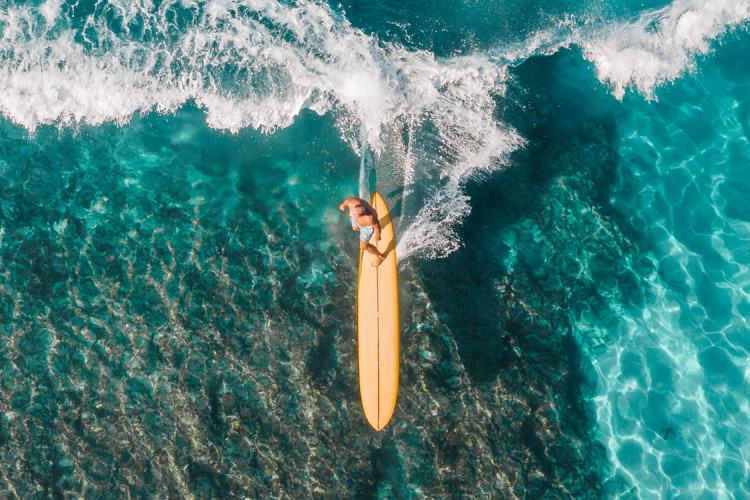During the late spring and early summer, I felt sufficiently advanced to have a go at some bigger waves.
Often, because of the crowded conditions at Canoe Surf, the three of us would venture out to Poplars and other locations in the bay.
In the last few months, we had learned a great deal about surfing at Waikiki.
I will try to consolidate this information in the next paragraphs.
Someone using the book in an attempt to improve his surfing technique could therefore start with this chapter - if he liked - since there is inevitably some repetition and refinement of what has gone before.
On a typical day in spring, Larry would call me on the telephone at 6:30 am.
I would shave quickly and put on my swimming trunks and an aloha shirt; then we would all pile into George's old Buick and drive down to the beach.
Honolulu is lovely in the early morning light, and all the wonderful foliage is fresh with the promise of the nascent day.
The Royal Poincianas on Wilder Avenue are coronets of pale green and scarlet backed, here and there, by the brilliant golden cupola of the sunshine tree, which is surely the world's most spectacular flowering tree.
Past Punahou School and its avenue of Cuban Royal palms we went, down McCully and over the bridge to the broad road beside the Ala Wai.
At this hour, the canal always seemed cool and grey and unreal, a long inverted mirror, with its quiet reflections and solitary line of coconuts leading to Diamond Head.
It is a thriftier landscape than the tropical luxury nearer the beach.
We would park behind the Princess Kaiulani Hotel and pad barefoot along the sidewalk to the Moana Hotel.
Between 6:30 and 7:30 am, the famous Banyan Terrace is usually being watered down by a Filipino janitor.
The terrace, a huge somber mass of dark dullness, presents a foreground in vivid contrast to the sudden blinding splash of dazzling blue sea and white breakers.
This scene has never failed to leave me breathless with anticipation.
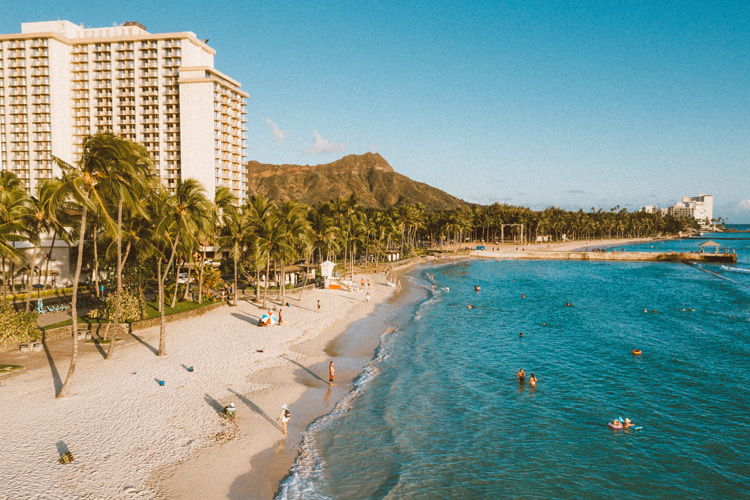
Getting to the Water
Many people carry their boards under one arm, but with an 11-foot board, I find it easier to carry mine over my shoulder.
If you stand the board skeg-down facing you, you can then hoist it onto your shoulder and use the side of your head and the right hand and forearm flat on the bottom of the board to balance it.
I wax the board in the water.
After that, I usually push the board out to sea for a hundred yards or so and swim after it doing the crawl to get the blood circulating.
Then, I leap aboard and start paddling to where the waves are building up. Gilbert had taught me to cross my feet when paddling, and it's a habit I have kept, although it's hard to say why.
Certainly, the feet tend to rise when you are pulling hard with your arms, and perhaps crossing them helps anchor them down to give you more stability.
After a while, you find paddling most enjoyable, your shoulders and arm muscles become increasingly large and powerful, and most of your friends will wince when you shake hands.
This increase in strength is just as well since when the waves are high at Waikiki, there is no opportunity to paddle around them - you have to paddle through them and over them, which may take as much as 20 minutes.
You need considerable physical endurance to stand this.
After a while, you find the rhythm most suitable to your strength and style, and you find that you can paddle indefinitely without resting.
Steering is variously affected by back paddling and/or dragging a foot on the same side.
When the waves are up, sand swirls - about ten feet in diameter - form at Waikiki. These are about 500 yards out in front of the Moana and are 75-100 feet apart.
Between these sand swirls is the best place to catch the waves.
Some of the beach boys also recommended lining up at the left-hand side of the Biltmore Hotel with the road going up the left side of St. Louis Heights, which is on the mountain slope behind.
As the waves get bigger, or when First Break surf is running, you can move further out.
Experienced surfers gauge the type of day it is - a three-foot, four-foot, or five-foot day, etc. Tom Zahn, for instance, moves back as he gets tired, catching fewer and larger waves.
Toward the end of my first month on the new schedule, the surf increased a little in size, and the sea got rougher.
I found the buffeting which I now received in paddling out to the breakers exhilarating but rather disquieting at 7 o'clock in the morning.
However, I was learning something all the time - that you should grip the rails and raise yourself up as if you were doing a push-up if you are paddling through soup or a breaking wave of any size.
Some people kick their legs into the air too. With your body above the board, there is less resistance to the flow of water.
If you don't do this, you may be forced back several yards or even lose control of the board.
In the old days, with the heavy boards, many surfers would punch their way through the waves and still manage to retain their boards.
This is still a possibility and the usual method of getting outside over larger waves.
However, you run the risk of getting caught in the break and "going over the falls" if the wave breaks before you get over the top.
Inspired judgment is needed to see whether or not you can make it.
You must paddle very hard from the front of the board to prevent the tip from coming up.
Nowadays, if you are confronted by soup or by small breaking waves, it is customary to turn the board over and get underneath it, face-turned toward the board and legs either kicking or wrapped around the board if the soup is heavy.
This technique will get you through some pretty rough stuff, but again it needs testing and practice to find its limits and potential for the individual surfer.
It is a good idea to get under the board, anyway, when there are loose boards floating around or if a wave full of surfers is approaching.
If you are surfing larger waves and there is the possibility of getting trapped by a set, it is better to wait until the sea is temporarily flat, or better still, to paddle around the area where the waves are breaking.
Only exceptionally powerful swimmers and surfers can battle their way through the big stuff. Most people make very slow headway, and each wave will throw them back many yards.
After you have reached the area where the waves are peaking, you turn around to await your first ride. Most surfers sit back toward the stern of the board while they are waiting for a wave to come.
The tip is about two feet above the water and is pointing at about 30 degrees from the place where the waves are beginning to form.
The board can be quickly turned by rotating your feet in circles in opposite directions and by taking opposite strokes with your hands if this is necessary.
If you are at all tired after your paddle, you should rest a while before trying to catch a wave since you will need all your strength and more if you are wiped out by a big one.
The same applies after repeated attempts to catch waves without success.
You should also watch your drift, as a man on a surfboard is easily moved about by the wind.
At most surfing beaches, you can learn a lot about the choice of wave and positioning by observing the experienced surfers present. Their number is usually proportional to the size of the waves.
When the surf is up, they appear from nowhere like soldiers lining up for the chuck wagon at an army camp which had seemed empty before the wagon's arrival.
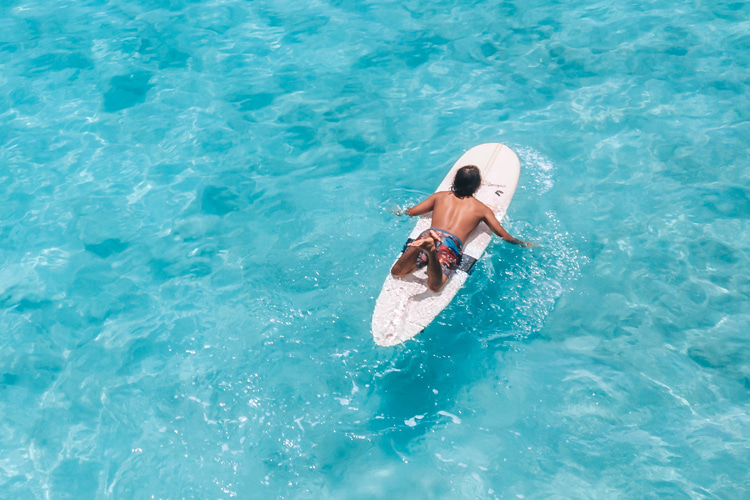
Catching the Wave
By this time, we had learned to catch the waves we wanted with the minimum necessary number of strokes.
If you are too far forward on the wave, to avoid pearl diving, you can either pull your chest up sharply or slide back on your board to get the right angle.
If you are getting up as quickly as you should, most pearls will be taken standing up.
As the wave approaches, paddle hard, and at the moment you feel the board being lifted, get up in one considered forward component; with your palms pushing the board forward, you snap upright, shoving the board further forward with the soles of your feet.
This takes practice and elan; it is a total movement like a difficult ballet step, but once mastered, you will miss very few waves.
Beginners often stop paddling before they have caught the wave and so lose it.
If you are too far back on the board or you cannot get up enough speed, pulling the body forward on the board at the last moment will sometimes slide you down into the wave.
In a bad pearl, the nose of the board bites into the water, throwing the surfer forward.
Because of the board's buoyancy, it will penetrate only a few feet and then catapult out again, re-entering the water tail first.
If this happens, the surfer should get at least four feet under the surface and cover his head with his hands, coming up after he has counted to seven while keeping a lookout for other surfers.
Avoiding pearls and other wave sense, as well as the knack of knowing whether or not you have caught the wave, develops rapidly with practice.
Wave Riding Techniques
Only beginners go straight on the waves at Waikiki, although if there are a great many surfers, you may have no choice.
To get the most out of a wave, you soon learn to either go into a severe side-slip or to change direction from side to side (hot dog) to stay on the wave for the maximum ride.
If you have a wide board, a too severe side-slip should be avoided since it will sometimes produce a tail spin, which is a nasty way of getting wiped out.
On smaller waves, you may find you just lose the wave.
If the waves are sizeable, you must keep your weight back to stay at the top of the wave and start side-slipping in the opposite direction from where the wave is breaking.
If you can stay in the curl adjacent to the break, this is ideal, as long as you keep out of the soup.
As the curl increases, you will have to pivot the board somewhat in the direction of the roll.
Keep up as high on the wave as you can, as you may lose much forward speed if you are near the bottom of the wave.
The speed of the board at this stage is controlled by your position on it. You can increase speed by walking toward the nose, foot over foot.
If you have been practicing board walking by hustling backward and forward on your board, your speed control will be almost automatic by this time.
If the wave is breaking, you may have to back-step one foot over the other until you have recovered control of the board.
You can then either kick out by applying weight to the extreme rear of the board and flicking it round with the lead foot, or you can turn straight and prone out; or if the wave is really big, you may have to sit back into the mass of water or dive to clear the board.
You cannot over-practice walking forward and back again to regain rear control.
It is one of the most fundamental exercises in surfing, enabling you to synchronize your speed to the variations of the breaking wave.
When riding the curl, most accomplished surfers cut out before the wave turns completely into white water to save paddling.
If at this moment a quick look around confirms another large set following, it is easier to ride out the wave and paddle around the side or wait for a lull, whichever seems the more reasonable solution.
One movement I have always found useful on a surfboard is a pushing sliding movement with the feet to give the board a sudden spurt.
It is performed by bending the knees and straightening them, changing the pressure from front to back foot, and shuffling a bit, if necessary.
This is especially useful when you are losing way, and you want to get back into the middle of a small wave at Waikiki.
It is also a good exercise in board control.
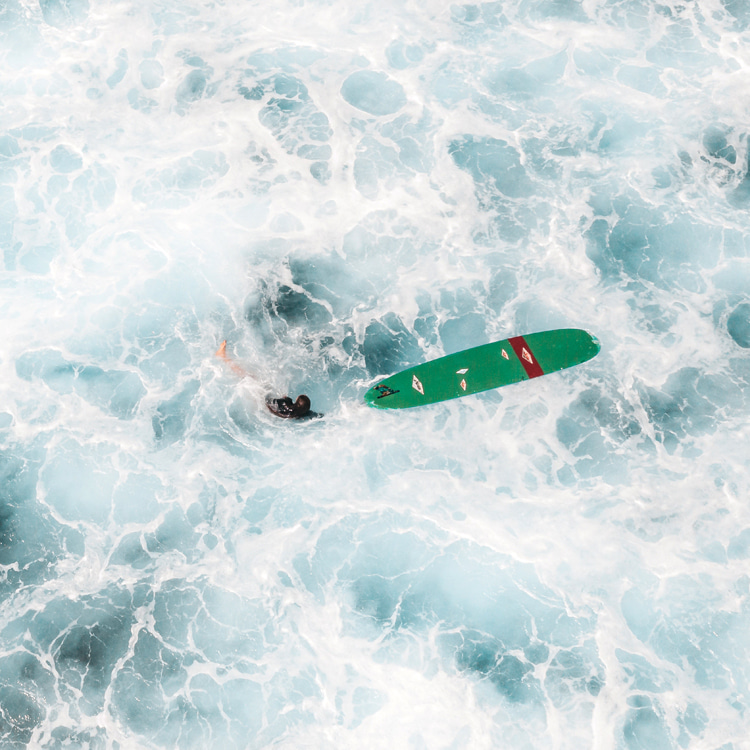
Sliding and Turning
Sliding sideways on the wave must involve turning, and a surfer shows his class when executing turns and cut-outs or kick-outs more distinctly than in any other aspect of this graceful sport.
Turning is a sensitive maneuver requiring complete knowledge and control of your board. It is a comparatively simple operation.
If you are side-slipping on a right slide with your left foot forward, most of your weight will be on your left foot, which is known as the lead or guide foot.
If you are a goofy foot and you surf right foot forward, from now on for left foot, read right foot where applicable.
The lead foot is the foot which is responsible for making slight changes of direction, for moving the board down the waves, and for maintaining your balance.
To turn left, you shift your weight to the rear or trail foot and apply pressure to the left side of the board, executing the turn with your heel.
The trail foot must be well toward the rear of the board. If necessary, take a step or several steps back to attain this position.
The lead foot is sometimes used to help pull the board around in a scissors motion.
A fast turn is especially easy at the top of an unbroken wave since only a small portion of the board is in the water.
Thus, it is cantilevered and will pivot readily when weight is applied to the rear and to the side you wish to turn.
You can then walk up in the side-slip as you fly away from the break.
To turn right, the process is merely reversed.
The trail foot presses on the right-hand side of the stern with all your weight on it. There is then no weight on the lead foot.
During these operations, you should keep your head over the board to maintain balance, although some surfers lean outward and use their arms and shoulders for this purpose.
While executing turns, the arms and the head are always useful for added balance. Extremely fast turns are an exception, as in these, you can sometimes use centrifugal force for support.
In all other turns, your center of gravity should always be over part of the board, and the feet should be on the side of the board closest to the wave; otherwise, the outside rail will knife downward into the water, and you will lose the wave.
This is known as "catching a rail."
Holding the rail will sometimes keep you in a steep wave that you would otherwise lose.
When you are back in the side-slip at a slight angle to the wave, you can move up or down the wave by pressing on the rear foot and experimenting with its position.
When turning hard in a breaking wave, you must have rear control, with your trail foot down on the board's stern so that the tip board is high out of the water; otherwise, you will pearl dive.
In rough water like this, you will need to be in the big wave stability stance. For this, the knees are bent at right angles, and the body is leaning forward.
The bent knees act as rubbery shock absorbers to give you maximum control of the board. You can spread your feet until maximum stability and comfort are attained.
With my wide 11-foot board, I found that I barely had enough way on to turn in smaller waves without inadvertently cutting out of the wave, although I noticed Barry Napoleon seemed to manage it with a 12-foot board!
But then, whenever I looked at him, he seemed to be tip-toeing along the board, adjusting the balance, a practice which all beginning surfers should note and attempt to emulate.
However, because of my own apparent lack of control, I developed a natural back arch turn which was so diverting that I no longer attempted to turn any other way in the smaller waves.
This turn is hard to describe.
All you do is lean backward and press down with the trail foot in the direction of the turn, and the board comes slowly but steadily around.
The more pronounced the arch while retaining your balance, the faster the turn.
This type of turn is a very personal maneuver which is a result of trial and error and is part of the process of union with your board, like a horse and rider, which all surfers should aim for.
Beginners usually pull out of a wave by falling off the board.
The dangerous capacity of a free-floating board has already been discussed, but it cannot be stressed too often.
So be careful to fall on top of the board, sit on it, or make a lunge for it, or at least get a hand or foot on top of the board.
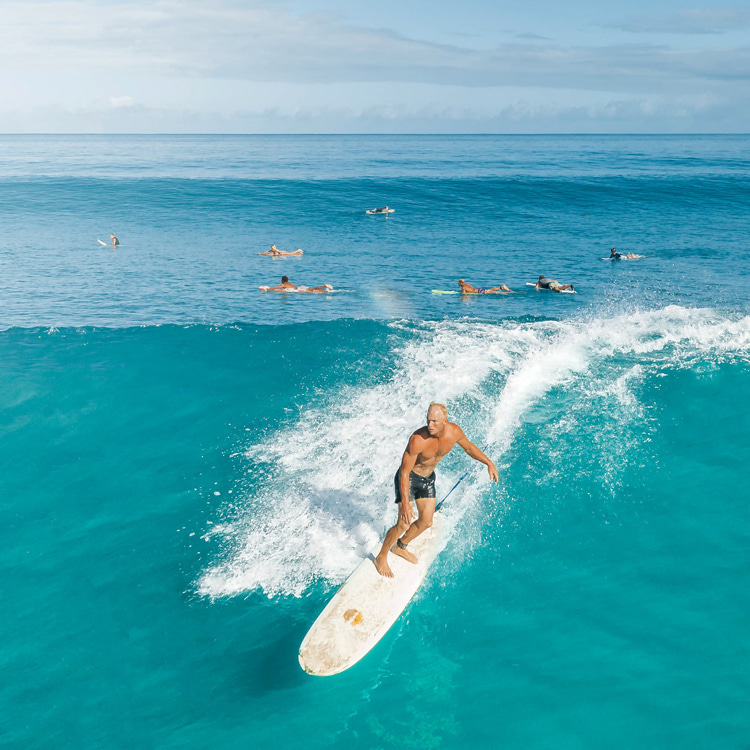
Kicking Out
If you press hard down with your hand, the tip of the board will come up, and the board will come to a stand-still. This can also be done standing up and is known as stalling the board.
When I started surfing, I went to great lengths to hang onto the board to avoid the desolate loneliness of the swimmer in a vast turbulent sea with his board disappearing over the horizon.
This unpleasant sensation, at least, makes you hang onto your board.
After a few attempts, you will find you can walk back foot over foot and sit down with an increasing degree of elegance until, eventually, you are ready to try the more spectacular type of cut-out, which is one of the most satisfying movements in surfing.
The cut-out or kick-out is an exaggerated turn with the lead foot following through in a kicking motion.
Move all your weight way back, and the tip of the board will rise sharply.
Take the weight off your lead foot and use it with a swiveling scissors motion to kick the board around.
As you approach the direction in which you want to paddle, grasp the rails with both hands and reassume the prone or kneeling position as soon as the board starts to approach the surface of the sea.
This is another of those total movements which has to be coordinated from start to finish but which, when once mastered, is done automatically and without thinking.
You should be careful to see that there is nobody within board length when you cut out of a wave.
The board can be swiveled around with terrific force, and its edge meeting skin or bone is like an exaggerated karate blow.
One of my friends spent several months in a hospital after receiving a blow on the calf from a spinning board - they say, in this case, it was not an accident.
Another friend wouldn't go near a surfer cutting out after he looked around once as he came toward the end of a wave.
What he saw was the evil, leering face of a hoodlum on a surfboard approaching him with the obvious intent to spin a board into him.
In a situation like that, you wonder how we get stuck with these people in the noble brotherhood of surfers.
Hotdogging Moves
The cult of the hot-dogger has achieved mammoth proportions in California and Australia, even though it is less frequently found in the Islands.
The only myth I can think of which is attached to the cult is that the practitioners are mainly blond-headed.
As a matter of fact, many of the best hot-doggers are dark.
Most hot-doggers, these days, are not merely content to zig-zag from side to side with their arms outstretched in a straight line.
They also want to do head dips, nose walking, toes over's, whip-turns, headstands, handstands, riding backward, tandem surfing, Quasimodos, Mysteriosos, El Spontaneos, and other improvisations of the fertile minds of the top exponents of hot-doggery.
Since most of these poses are minor contortions of the body which could be just as easily performed in a gymnasium or at home, there is little point in describing them in detail here.
There is no doubt, however, of their fatal fascination, and most orthodox surfers are guilty of some hotdogging from time to time.
Mickey Munoz of California, Donald Takayama of Honolulu, and Midget Farrelly of Australia are the acknowledged masters of this style, although Mickey Dora and Dewey Weber, as well as Mickey Murioz and other California surfers, were responsible for its development.
Head dips are really a method of cutting out. You seize the tip of the board in both hands and dive back into the wave.
Nose riding is good practice in board handling and is merely an advanced form of board walking.
You need plenty of speed to hang your toes over the edge, which is a difficult performance. One foot is called five toes over; two feet is ten toes over.
Headstands are easy on a surfboard, as long as your head is at the point where your feet would normally be. You grip the sides of the board strongly with your hands, forming a triangle with your head.
Handstands are similar but much more difficult.
Riding backward is performed by lifting up one foot and switching around on the other.
There are seven different required rides for competition in tandem surfing, ranging from two people standing on the same board to the shoulder stand or the swan.
Quasimodos and other variations of the head between the legs are spontaneous contortions.
If you want to put on a classical performance in these fields, watch a top performer like those mentioned above.
If you are merely interested in self-expression, the sky is the limit, but you'd better practice first in a gymnasium to avoid as many broken bones as possible.
All surfers have their characteristics, which are often so vivid and personal that you can recognize them immediately, even though they are way out to sea.
Those characteristics are strongest in the way they hold their arms.
Larry holds his down in a primordial way as if he were about to prone out. George winds up his right arm as if he had a barrel organ aboard, and Bob Hansen holds his arms in the air in a V-shape, like an angel in a grade school play.
I'm told I always turn my palms outward as if I were going to ward off any competition.
Characteristics are all very well, but style is another thing entirely. A person's form and expression are important in a sport as strongly visual as surfing.
The superior surfer makes it look easy.
There are no wildly waving arms nor violent movements to regain a balance which should never have been lost.
Kemp Aaberg, L. J. Richards and Phil Edwards are considered three of the best and most relaxed of the present-day surfers. Although they have made the trip to the Islands, their home is in California.
Buffalo Keaulana, Conrad Canha, and George Downing are three of the many stylish surfers in the Islands.
Few surfers on polyurethane boards can approach the statuesque poise of the old surfers like Sam or Duke Kahanamoku on their heavy redwood boards.
Style means good form and good decisions.
Veteran surfers only go for sure-thing waves; they evaluate each wave carefully; they ride them from the peak, not the shoulders; and they use only three positions, making each one clear by exaggeration, if necessary.
They are:
1. The relaxed good posture position in stable waves;
2. The big wave stability stance;
3. The rail-hold and prone-out;
These positions have either been described before, or they are self-evident. Surfers practicing should try these various positions as often as possible and change from one to the other.
The most common fault, says veteran surfer Mud Werner, is to ride a wave in a stance which is neither fish nor fowl but a mixture of good posture position and the big wave stance.
The best way to achieve a good style is to watch those who have it and find out why you think they do.
You can then use this knowledge to improve and develop your own personal style without having to copy them blindly.
Clear-cut decisions are also the mark of the good surfer. Inexperienced surfers are always making mixed decisions.
If you decide to back out of a big one, do it quickly.
If you see another surfer approaching on a left slide while you are on a right, you must make up your mind in a split second, for, in this case, the alternative is not pleasant to contemplate.
Words by Desmond Muirhead | Golf Course Designer and Author of the Book "Surfing in Hawaii" (1962)
Chapter VIII of "Surfing in Hawaii" was published under the authorization of Rosemary J. Muirhead, one of the three daughters of Desmond Muirhead
